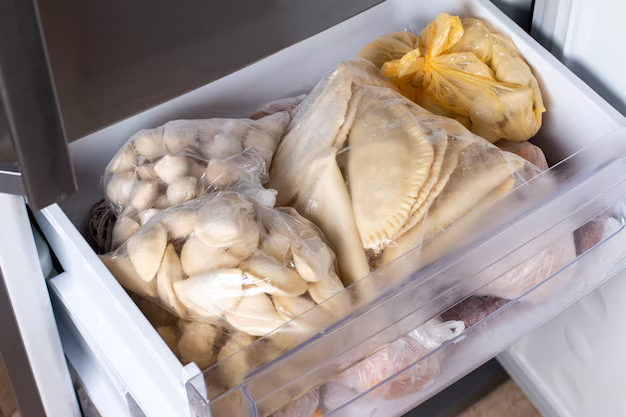🐖 How Long Does Cooked Pork Last in Your Refrigerator?
Imagine this: you've just finished a delightful pork roast dinner, and there are generous leftovers. The succulent slices sit on your counter, and a question looms in your mind—how long will these remain safe to savor in your fridge? Proper storage of cooked pork is not just about preserving taste; it’s also crucial for your health. Here’s a deep dive into how to store cooked pork safely and optimize its shelf life.
🥡 Understanding Cooked Pork's Shelf Life
When it comes to cooked pork, its shelf life in the refrigerator typically ranges from three to four days. This timeline ensures both safety and quality. However, several factors can influence this duration:
- Refrigerator Temperature: Always keep your fridge at or below 40°F (4°C).
- Storage Method: Airtight containers or tightly wrapped packages help preserve freshness and prevent contamination.
- Cooked State: Fully cooked pork lasts longer than partly cooked dishes.
Knowing when your cooked pork was prepared is vital to keeping track of its lifespan. Labeling leftovers with the date they were made will help you manage your fridge neatly and efficiently.
🥶 The Science Behind Refrigerated Food Spoilage
Each type of bacteria has its comfort zone, a temperature range where it thrives best. The goal of refrigeration is to slow down bacterial growth and keep food within safe limits. However, it doesn't stop microorganisms entirely. Here's why your pork leftovers can't be stored indefinitely:
- Psychrotrophic bacteria can grow slowly even in cool temperatures, potentially leading to spoilage.
- Enzyme activity in the food can cause degradation over time, impacting texture and taste.
- Lipid oxidation in meats, especially those high in fat, might result in rancidity even in the fridge.
Understanding these factors emphasizes why it's essential to consume refrigerated pork within the recommended timeframe.
🦠 Recognizing Spoilage Signs
Relying on your senses is an effective first step in assessing whether your pork is still fit for consumption. Here's what to look for:
- Smell: A sour or off odor is often the first sign of spoilage.
- Texture: If the meat feels sticky or slimy, it's time to discard it.
- Color: Pork that appears dull or has grayish hues could indicate bacterial growth.
If there's doubt about its safety, it’s always best to err on the side of caution and throw it out.
🌡️ Ideal Storage Practices for Cooked Pork
Maximizing the shelf life of your cooked pork involves incorporating optimal storage techniques:
Cool Promptly: Once dinner is over, allow your pork to cool at room temperature but not for more than 2 hours before refrigeration.
Seal Securely: Use airtight containers or wrap pork tightly with aluminum foil or plastic wrap. This step is crucial to prevent drying out and contamination.
Vacuum Sealing: If you have the equipment, vacuum-sealing can extend the refrigeration life of pork by reducing oxygen exposure.
🥘 Pork Storage: Various Scenarios
Different pork dishes have diverse characteristics. Thus, how you store them can vary slightly based on the dish:
🍖 Whole Pork Roasts
A whole roasted pork offers more protection than sliced, given its reduced surface area subjected to air exposure. To store properly:
- Carve strategic portions to minimize repeated exposure for the unconsumed parts.
- Wrap the entire roast in foil before placing it in an airtight container.
🌮 Pulled Pork
This tender delicacy can dry out or spoil faster due to its shredded nature:
- Submerge shredded portions in some reserved cooking juices before refrigerating to maintain moisture.
- Check for oil separation, which can lead to quicker spoilage.
🥩 Sliced Pork
For cut slices:
- Layer them with parchment before stacking to prevent them from sticking together.
- Ensure full coverage with wrap or foil to guard edges against drying out.
🔍 Exploring Freezing for Extended Storage
If consuming within a few days isn't feasible, freezing offers a superb extension of pork's life span, allowing it to stay fresh for months.
❄️ Freezing Tips
- Use Freezer-Safe Bags or Containers: This ensures no air penetration affecting taste and quality.
- Freeze Quickly: The faster the pork freezes, the better it retains its texture post-thaw. Arrange packages in a single layer to facilitate quick freezing.
- Label Clearly: Indicate not only the date but also the portion size to minimize unnecessary thawing.
🕓 How Long Is Frozen Pork Good?
Cooked pork that's been frozen can be used within two to three months without quality loss. Longer storage may lead to freezer burn, affecting flavor and texture.
📋 Quick Tips for Cooked Pork Storage
Here's a handy checklist to ensure you’re following the best storage practices for your cooked pork:
- 🚫 Avoid Overcrowding: Air circulation in the fridge is essential.
- 🥤 Heat Thoroughly: When reheating, ensure internal temperatures reach 165°F (74°C) to eliminate bacteria.
- 🍲 Reheat Only Once: Repeated heating can degrade quality.
- ⏲️ Timing Matters: Always time meals and their cleanup to minimize room temperature exposure.
🏆 Recap: Keeping Your Pork Perfectly Preserved
In essence, the optimal preservation of cooked pork involves understanding both the scientific and practical aspects of food storage. By carefully managing temperature, storage medium, and timing, you can ensure delicious meals and healthy consumption. Here’s a quick summary with emojis for easy memorization:
- 📅 3-4 days in the fridge is the recommended shelf life.
- ❌ Discard if off-smell or discoloration occurs.
- ❄️ Freezing extends life for months but mind quality.
- 👍 Always reheat to kill bacteria effectively.
- 🔖 Label dates to keep track easily.
Through thoughtful handling, cooked pork can remain a tasty and safe delight in your culinary arsenal, ensuring each meal is as enjoyable and nourishing as the last. Happy eating!
